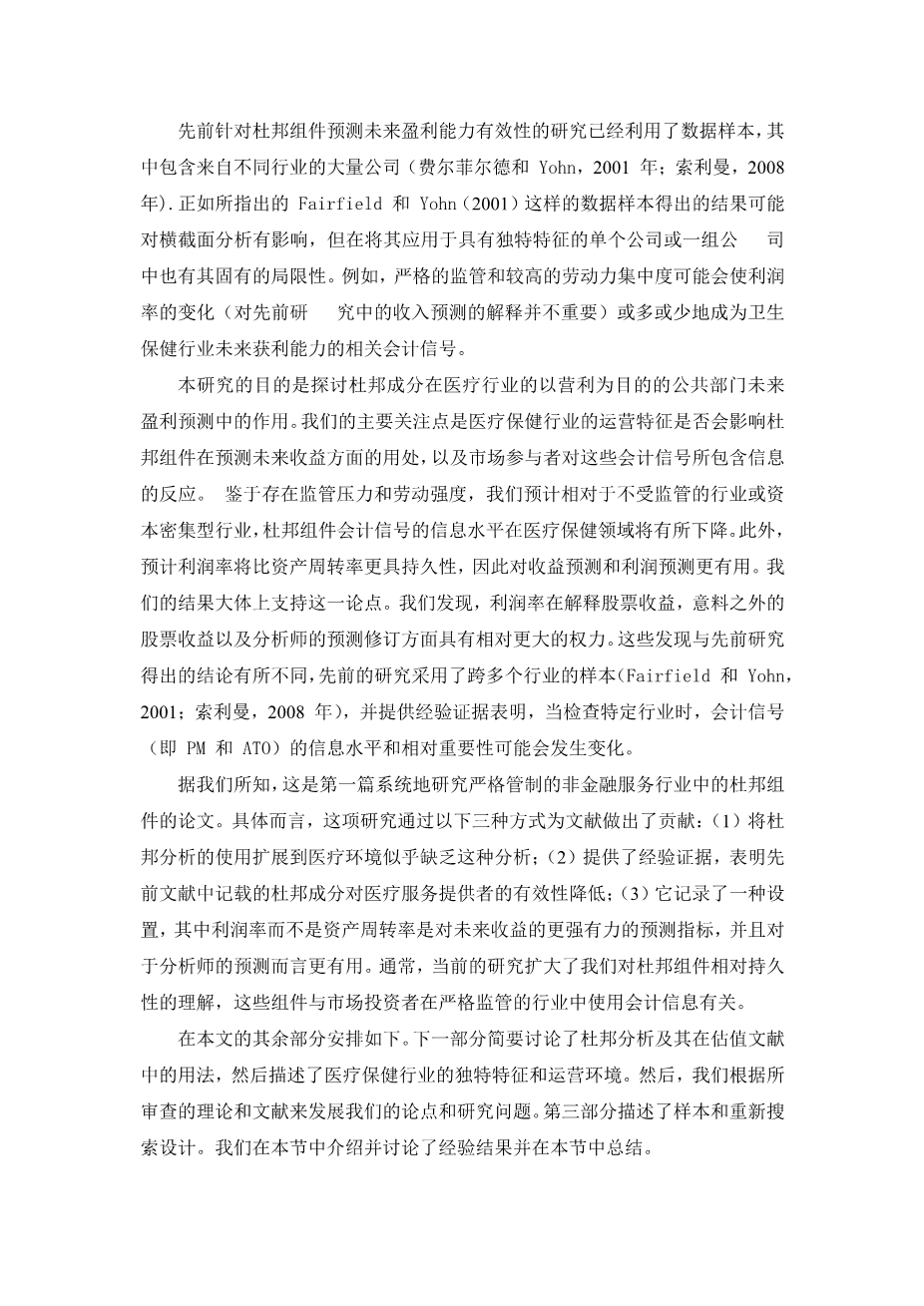On The DuPont Analysis in The Health Care Industry
abstract
Prior research documents that the DuPont components of return on net operating assets (profifit margin and asset turnover) represent an incremental source of information about the operating characteristics of a fifirm and are useful tools for market participants (Soliman, 2008). We fifind that the informativeness of DuPont components about future profifitability is reduced in the healthcare setting, relative to an all-industry sample. Moreover, to the extent that DuPont components are useful for market participants, we show that profifit margin is more persistent than asset turnover for US for-profifit health care providers, which contradicts the results documented in prior literature that considered all industries. We argue that the special features of the health care industry (i.e. heavy regulation, unique operational characteristics) affect the
information content of accounting signals obtained based on fifinancial statements.
1. Introduction
This study investigates the usefulness of the information contained in the DuPont Financial Analysis Model (DuPont analysis, hereafter) for the health care industry equity analysts and stock market investors. By decomposing return on assets into profifit margin (PM) and asset turnover (ATO), the DuPont analysis enables market participants to better understand the source of superior (or inferior) return information contained in the fifinancial statements in comparison with companies in the same industry or between industries. Three main factors motivate our interest in the health care industry: (1) it is a highly regulated industry; (2) the government is its largest customer (e.g. Medicare and Medicaid); and (3) it is a labor intensive industry. These factors potentially affect the information content of PM and ATO and provide a fertile research environment to investigate the usefulness of DuPont components in predicting future profifitability of healthcare fifirms.
The health care industry, similar to the public utilities, transportation and telecommunications
industries, is strongly inflfluenced by government regulations. These regulations are imposed to ensure quality of care, facilitate the governmentrsquo;s role as a major purchaser of medical care, and respond to provider efforts to increase the demand for their services (Morrisey, 2010). Publicly traded for-profifit healthcare fifirms in the US provide a unique opportunity to compare the effect of government regulations on the informativeness of particular accounting signals for market participants.
Prior research that focuses on the effectiveness of DuPont components for predicting future profitability has utilized data samples containing a large set of fifirms from different industries (Fairfifield and Yohn, 2001; Soliman, 2008). As pointed out by Fairfifield and Yohn (2001), results derived from such data samples may have implications for cross-sectional analyses, but also have inherent limitations in their application to a single fifirm or group of fifirms with unique characteristics. Heavy regulation and a higher level of labor concentration, for example, may make changes in profifit margin (which is not signifificant in explaining earnings forecast in prior studies) a more or less relevant accounting signal of future profifitability within the health care industry.
The objective of the current study is to explore the usefulness of DuPont components in future earnings prediction for the publicly traded for-profifit sector of the health care industry.3 Our primary focus is on whether the operational characteristics of the health care industry affect the usefulness of DuPont components in forecasts of future earnings, as well as the market participantsrsquo; reaction to the information contained in these accounting signals.4 Given the presence of regulatory pressures and labor intensiveness, we expect the information level of accounting signals of DuPont components to be reduced in the health care setting relative to unregulated industries or more capital intensive industries. Moreover, PM is expected to be more persistent than ATO and thus more useful for earnings forecast and profifit prediction. Our results generally support this argument. We fifind that PM, rather than ATO, has relatively more power in explaining stock returns, unexpected stock returns, and analystsrsquo; forecast revision. Such fifindings are different from the conclusion derived in prior studies that have employed samples spanning several industries (Fairfifield and Yohn, 2001; Soliman, 2008) and offer empirical evidence that the level of informativeness and relative importance of accounting signals (i.e. PM and ATO) may be changed when a specifific industry is examined.
To the best of our knowledge, this is the fifirst paper to systematically investigate the DuPont components in a heavily regulated non-fifinancial service industry. Specififically, this study contributes to the literature in three ways: (1) it extends the use of DuPont analysis to the healthcare environment where such analysis appears to be lacking; (2) it provides empirical evidence that the effectiveness of DuPont components documented in the prior literature is reduced for health care providers; and (3) it documents a setting where profifit margin, rather than asset turnover, is a stronger predictor of future earnings and a more useful signal for analystsrsquo; forecast. Generally, the current study expands our understanding of the relative persistence of DuPont components associated with market investorsrsquo; use of accounting information within a heavily regulated industry.
The remainder of the paper is organized as follows. The next section brieflfly discusses DuPont analysis and its usage in the valuation literature, followed by a description of the unique characteristics and operating environment of the health care industry. We th
剩余内容已隐藏,支付完成后下载完整资料


英语译文共 4 页,剩余内容已隐藏,支付完成后下载完整资料
资料编号:[607173],资料为PDF文档或Word文档,PDF文档可免费转换为Word


